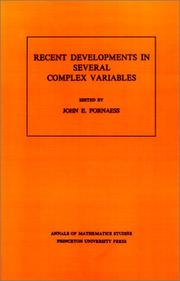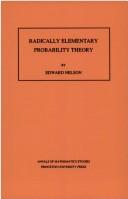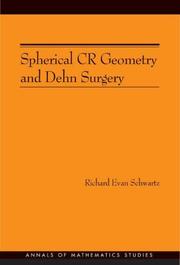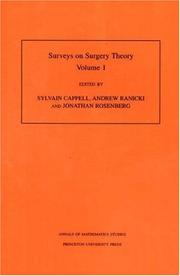| Listing 1 - 10 of 28 | << page >> |
Sort by
|
Book
ISBN: 0691080135 1400869226 Year: 1977 Publisher: Princeton, N.J.
Abstract | Keywords | Export | Availability | Bookmark
 Loading...
Loading...Choose an application
- Reference Manager
- EndNote
- RefWorks (Direct export to RefWorks)
The ∂̄ Neumann problem is probably the most important and natural example of a non-elliptic boundary value problem, arising as it does from the Cauchy-Riemann equations. It has been known for some time how to prove solvability and regularity by the use of L2 methods. In this monograph the authors apply recent methods involving the Heisenberg group to obtain parametricies and to give sharp estimates in various function spaces, leading to a better understanding of the ∂̄ Neumann problem. The authors have added substantial background material to make the monograph more accessible to students.Originally published in 1977.The Princeton Legacy Library uses the latest print-on-demand technology to again make available previously out-of-print books from the distinguished backlist of Princeton University Press. These editions preserve the original texts of these important books while presenting them in durable paperback and hardcover editions. The goal of the Princeton Legacy Library is to vastly increase access to the rich scholarly heritage found in the thousands of books published by Princeton University Press since its founding in 1905.
Partial differential equations --- Neumann problem. --- Neumann problem --- Mathematics --- Physical Sciences & Mathematics --- Calculus --- Boundary value problems --- Differential equations, Partial --- A priori estimate. --- Abuse of notation. --- Analytic continuation. --- Analytic function. --- Approximation. --- Asymptotic expansion. --- Asymptotic formula. --- Basis (linear algebra). --- Besov space. --- Boundary (topology). --- Boundary value problem. --- Boundedness. --- Calculation. --- Cauchy's integral formula. --- Cauchy–Riemann equations. --- Change of variables. --- Characterization (mathematics). --- Combination. --- Commutative property. --- Commutator. --- Complex analysis. --- Complex manifold. --- Complex number. --- Computation. --- Convolution. --- Coordinate system. --- Corollary. --- Counterexample. --- Derivative. --- Determinant. --- Differential equation. --- Dimension (vector space). --- Dimension. --- Dimensional analysis. --- Dirichlet boundary condition. --- Eigenvalues and eigenvectors. --- Elliptic boundary value problem. --- Equation. --- Error term. --- Estimation. --- Even and odd functions. --- Existential quantification. --- Function space. --- Fundamental solution. --- Green's theorem. --- Half-space (geometry). --- Hardy's inequality. --- Heisenberg group. --- Holomorphic function. --- Infimum and supremum. --- Integer. --- Integral curve. --- Integral expression. --- Inverse function. --- Invertible matrix. --- Iteration. --- Laplace's equation. --- Left inverse. --- Lie algebra. --- Lie group. --- Linear combination. --- Logarithm. --- Lp space. --- Mathematical induction. --- Neumann boundary condition. --- Notation. --- Open problem. --- Orthogonal complement. --- Orthogonality. --- Parametrix. --- Partial derivative. --- Pointwise. --- Polynomial. --- Principal branch. --- Principal part. --- Projection (linear algebra). --- Pseudo-differential operator. --- Quantity. --- Recursive definition. --- Schwartz space. --- Scientific notation. --- Second derivative. --- Self-adjoint. --- Singular value. --- Sobolev space. --- Special case. --- Standard basis. --- Stein manifold. --- Subgroup. --- Subset. --- Summation. --- Support (mathematics). --- Tangent bundle. --- Theorem. --- Theory. --- Upper half-plane. --- Variable (mathematics). --- Vector field. --- Volume element. --- Weak solution. --- Neumann, Problème de --- Equations aux derivees partielles --- Problemes aux limites
Book
ISBN: 069108176X 1322884951 1400869307 0691636443 Year: 1978 Publisher: Princeton, N.J.
Abstract | Keywords | Export | Availability | Bookmark
 Loading...
Loading...Choose an application
- Reference Manager
- EndNote
- RefWorks (Direct export to RefWorks)
The classical uniformization theorem for Riemann surfaces and its recent extensions can be viewed as introducing special pseudogroup structures, affine or projective structures, on Riemann surfaces. In fact, the additional structures involved can be considered as local forms of the uniformizations of Riemann surfaces. In this study, Robert Gunning discusses the corresponding pseudogroup structures on higher-dimensional complex manifolds, modeled on the theory as developed for Riemann surfaces.Originally published in 1978.The Princeton Legacy Library uses the latest print-on-demand technology to again make available previously out-of-print books from the distinguished backlist of Princeton University Press. These editions preserve the original texts of these important books while presenting them in durable paperback and hardcover editions. The goal of the Princeton Legacy Library is to vastly increase access to the rich scholarly heritage found in the thousands of books published by Princeton University Press since its founding in 1905.
Analytical spaces --- Differential geometry. Global analysis --- Complex manifolds --- Connections (Mathematics) --- Pseudogroups --- Mathematics --- Physical Sciences & Mathematics --- Calculus --- Global analysis (Mathematics) --- Lie groups --- Geometry, Differential --- Analytic spaces --- Manifolds (Mathematics) --- Adjunction formula. --- Affine connection. --- Affine transformation. --- Algebraic surface. --- Algebraic torus. --- Algebraic variety. --- Analytic continuation. --- Analytic function. --- Automorphic function. --- Automorphism. --- Bilinear form. --- Canonical bundle. --- Characterization (mathematics). --- Cohomology. --- Compact Riemann surface. --- Complex Lie group. --- Complex analysis. --- Complex dimension. --- Complex manifold. --- Complex multiplication. --- Complex number. --- Complex plane. --- Complex torus. --- Complex vector bundle. --- Contraction mapping. --- Covariant derivative. --- Differentiable function. --- Differentiable manifold. --- Differential equation. --- Differential form. --- Differential geometry. --- Differential operator. --- Dimension (vector space). --- Dimension. --- Elliptic operator. --- Elliptic surface. --- Enriques surface. --- Equation. --- Existential quantification. --- Explicit formula. --- Explicit formulae (L-function). --- Exterior derivative. --- Fiber bundle. --- General linear group. --- Geometric genus. --- Group homomorphism. --- Hausdorff space. --- Holomorphic function. --- Homomorphism. --- Identity matrix. --- Invariant subspace. --- Invertible matrix. --- Irreducible representation. --- Jacobian matrix and determinant. --- K3 surface. --- Kähler manifold. --- Lie algebra representation. --- Lie algebra. --- Line bundle. --- Linear equation. --- Linear map. --- Linear space (geometry). --- Linear subspace. --- Manifold. --- Mathematical analysis. --- Mathematical induction. --- Ordinary differential equation. --- Partial differential equation. --- Permutation. --- Polynomial. --- Principal bundle. --- Projection (linear algebra). --- Projective connection. --- Projective line. --- Pseudogroup. --- Quadratic transformation. --- Quotient space (topology). --- Representation theory. --- Riemann surface. --- Riemann–Roch theorem. --- Schwarzian derivative. --- Sheaf (mathematics). --- Special case. --- Subalgebra. --- Subgroup. --- Submanifold. --- Symmetric tensor. --- Symmetrization. --- Tangent bundle. --- Tangent space. --- Tensor field. --- Tensor product. --- Tensor. --- Theorem. --- Topological manifold. --- Uniformization theorem. --- Uniformization. --- Unit (ring theory). --- Vector bundle. --- Vector space. --- Fonctions de plusieurs variables complexes --- Variétés complexes

ISBN: 0691032165 140088392X 9780691032160 Year: 1993 Volume: 43 Publisher: Princeton (N.J.): Princeton university press,
Abstract | Keywords | Export | Availability | Bookmark
 Loading...
Loading...Choose an application
- Reference Manager
- EndNote
- RefWorks (Direct export to RefWorks)
This book contains an exposition of some of the main developments of the last twenty years in the following areas of harmonic analysis: singular integral and pseudo-differential operators, the theory of Hardy spaces, Lsup estimates involving oscillatory integrals and Fourier integral operators, relations of curvature to maximal inequalities, and connections with analysis on the Heisenberg group.
Harmonic analysis. Fourier analysis --- Harmonic analysis --- Analyse harmonique --- Harmonic analysis. --- Analysis (Mathematics) --- Functions, Potential --- Potential functions --- Banach algebras --- Calculus --- Mathematical analysis --- Mathematics --- Bessel functions --- Fourier series --- Harmonic functions --- Time-series analysis --- Groupe de Heisenberg. --- Addition. --- Analytic function. --- Asymptote. --- Asymptotic analysis. --- Asymptotic expansion. --- Asymptotic formula. --- Automorphism. --- Axiom. --- Banach space. --- Bessel function. --- Big O notation. --- Bilinear form. --- Borel measure. --- Boundary value problem. --- Bounded function. --- Bounded mean oscillation. --- Bounded operator. --- Boundedness. --- Cancellation property. --- Cauchy's integral theorem. --- Cauchy–Riemann equations. --- Characteristic polynomial. --- Characterization (mathematics). --- Commutative property. --- Commutator. --- Complex analysis. --- Convolution. --- Differential equation. --- Differential operator. --- Dimension (vector space). --- Dimension. --- Dirac delta function. --- Dirichlet problem. --- Elliptic operator. --- Existential quantification. --- Fatou's theorem. --- Fourier analysis. --- Fourier integral operator. --- Fourier inversion theorem. --- Fourier series. --- Fourier transform. --- Fubini's theorem. --- Function (mathematics). --- Fundamental solution. --- Gaussian curvature. --- Hardy space. --- Harmonic function. --- Heisenberg group. --- Hilbert space. --- Hilbert transform. --- Holomorphic function. --- Hölder's inequality. --- Infimum and supremum. --- Integral transform. --- Interpolation theorem. --- Lagrangian (field theory). --- Laplace's equation. --- Lebesgue measure. --- Lie algebra. --- Line segment. --- Linear map. --- Lipschitz continuity. --- Locally integrable function. --- Marcinkiewicz interpolation theorem. --- Martingale (probability theory). --- Mathematical induction. --- Maximal function. --- Meromorphic function. --- Multiplication operator. --- Nilpotent Lie algebra. --- Norm (mathematics). --- Number theory. --- Operator theory. --- Order of integration (calculus). --- Orthogonality. --- Oscillatory integral. --- Poisson summation formula. --- Projection (linear algebra). --- Pseudo-differential operator. --- Pseudoconvexity. --- Rectangle. --- Riesz transform. --- Several complex variables. --- Sign (mathematics). --- Singular integral. --- Sobolev space. --- Special case. --- Spectral theory. --- Square (algebra). --- Stochastic differential equation. --- Subharmonic function. --- Submanifold. --- Summation. --- Support (mathematics). --- Theorem. --- Translational symmetry. --- Uniqueness theorem. --- Variable (mathematics). --- Vector field. --- Fourier, Analyse de --- Fourier, Opérateurs intégraux de

ISBN: 0691082847 0691082790 1400881447 9780691082844 Year: 1981 Volume: 99 Publisher: Princeton (N.J.): Princeton university press,
Abstract | Keywords | Export | Availability | Bookmark
 Loading...
Loading...Choose an application
- Reference Manager
- EndNote
- RefWorks (Direct export to RefWorks)
The theory of Toeplitz operators has come to resemble more and more in recent years the classical theory of pseudodifferential operators. For instance, Toeplitz operators possess a symbolic calculus analogous to the usual symbolic calculus, and by symbolic means one can construct parametrices for Toeplitz operators and create new Toeplitz operators out of old ones by functional operations.If P is a self-adjoint pseudodifferential operator on a compact manifold with an elliptic symbol that is of order greater than zero, then it has a discrete spectrum. Also, it is well known that the asymptotic behavior of its eigenvalues is closely related to the behavior of the bicharacteristic flow generated by its symbol.It is natural to ask if similar results are true for Toeplitz operators. In the course of answering this question, the authors explore in depth the analogies between Toeplitz operators and pseudodifferential operators and show that both can be viewed as the "quantized" objects associated with functions on compact contact manifolds.
Operator theory --- Toeplitz operators --- Spectral theory (Mathematics) --- 517.984 --- Spectral theory of linear operators --- Toeplitz operators. --- Spectral theory (Mathematics). --- 517.984 Spectral theory of linear operators --- Operators, Toeplitz --- Linear operators --- Functional analysis --- Hilbert space --- Measure theory --- Transformations (Mathematics) --- Algebraic variety. --- Asymptotic analysis. --- Asymptotic expansion. --- Big O notation. --- Boundary value problem. --- Change of variables. --- Chern class. --- Codimension. --- Cohomology. --- Compact group. --- Complex manifold. --- Complex vector bundle. --- Connection form. --- Contact geometry. --- Corollary. --- Cotangent bundle. --- Curvature form. --- Diffeomorphism. --- Differentiable manifold. --- Dimensional analysis. --- Discrete spectrum. --- Eigenvalues and eigenvectors. --- Elaboration. --- Elliptic operator. --- Embedding. --- Equivalence class. --- Existential quantification. --- Exterior (topology). --- Fourier integral operator. --- Fourier transform. --- Hamiltonian vector field. --- Holomorphic function. --- Homogeneous function. --- Hypoelliptic operator. --- Integer. --- Integral curve. --- Integral transform. --- Invariant subspace. --- Lagrangian (field theory). --- Lagrangian. --- Limit point. --- Line bundle. --- Linear map. --- Mathematics. --- Metaplectic group. --- Natural number. --- Normal space. --- One-form. --- Open set. --- Operator (physics). --- Oscillatory integral. --- Parallel transport. --- Parameter. --- Parametrix. --- Periodic function. --- Polynomial. --- Projection (linear algebra). --- Projective variety. --- Pseudo-differential operator. --- Q.E.D. --- Quadratic form. --- Quantity. --- Quotient ring. --- Real number. --- Scientific notation. --- Self-adjoint. --- Smoothness. --- Spectral theorem. --- Spectral theory. --- Square root. --- Submanifold. --- Summation. --- Support (mathematics). --- Symplectic geometry. --- Symplectic group. --- Symplectic manifold. --- Symplectic vector space. --- Tangent space. --- Theorem. --- Todd class. --- Toeplitz algebra. --- Toeplitz matrix. --- Toeplitz operator. --- Trace formula. --- Transversal (geometry). --- Trigonometric functions. --- Variable (mathematics). --- Vector bundle. --- Vector field. --- Vector space. --- Volume form. --- Wave front set. --- Opérateurs pseudo-différentiels

ISBN: 0691082855 0691082812 1400881544 Year: 1981 Publisher: Princeton (N.J.) : Princeton university press,
Abstract | Keywords | Export | Availability | Bookmark
 Loading...
Loading...Choose an application
- Reference Manager
- EndNote
- RefWorks (Direct export to RefWorks)
The description for this book, Recent Developments in Several Complex Variables. (AM-100), Volume 100, will be forthcoming.
Complex analysis --- Functions of several complex variables. --- Complex variables --- Several complex variables, Functions of --- Functions of complex variables --- Analytic continuation. --- Analytic function. --- Analytic set. --- Analytic space. --- Asymptotic expansion. --- Automorphic function. --- Axiom. --- Base change. --- Bergman metric. --- Betti number. --- Big O notation. --- Bilinear form. --- Boundary value problem. --- CR manifold. --- Canonical bundle. --- Cauchy problem. --- Cauchy–Riemann equations. --- Characteristic variety. --- Codimension. --- Coefficient. --- Cohomology ring. --- Cohomology. --- Commutative property. --- Commutator. --- Compactification (mathematics). --- Complete intersection. --- Complete metric space. --- Complex dimension. --- Complex manifold. --- Complex number. --- Complex plane. --- Complex projective space. --- Complex space. --- Complex-analytic variety. --- Degeneracy (mathematics). --- Dense set. --- Determinant. --- Diffeomorphism. --- Differentiable function. --- Dimension (vector space). --- Dimension. --- Eigenvalues and eigenvectors. --- Embedding. --- Existential quantification. --- Explicit formulae (L-function). --- Fermat curve. --- Fiber bundle. --- Fundamental solution. --- Gorenstein ring. --- Hartogs' extension theorem. --- Hilbert space. --- Hilbert transform. --- Holomorphic function. --- Homotopy. --- Hyperfunction. --- Hypersurface. --- Hypoelliptic operator. --- Interpolation theorem. --- Irreducible component. --- Isometry. --- Linear map. --- Manifold. --- Maximal ideal. --- Monic polynomial. --- Monotonic function. --- Multiple integral. --- Nilpotent Lie algebra. --- Norm (mathematics). --- Open set. --- Orthogonal group. --- Parametrization. --- Permutation. --- Plurisubharmonic function. --- Polynomial. --- Principal bundle. --- Principal part. --- Principal value. --- Projection (linear algebra). --- Projective line. --- Proper map. --- Quadratic function. --- Real projective space. --- Resolution of singularities. --- Riemann surface. --- Riemannian manifold. --- Sectional curvature. --- Sheaf cohomology. --- Special case. --- Submanifold. --- Subset. --- Symplectic vector space. --- Tangent space. --- Theorem. --- Topology. --- Uniqueness theorem. --- Unit disk. --- Unit sphere. --- Variable (mathematics). --- Vector bundle. --- Vector field. --- Fonctions de variables complexes --- Colloque

ISBN: 0691084734 0691084742 1400882141 Year: 1987 Publisher: Princeton Princeton University Press
Abstract | Keywords | Export | Availability | Bookmark
 Loading...
Loading...Choose an application
- Reference Manager
- EndNote
- RefWorks (Direct export to RefWorks)
Using only the very elementary framework of finite probability spaces, this book treats a number of topics in the modern theory of stochastic processes. This is made possible by using a small amount of Abraham Robinson's nonstandard analysis and not attempting to convert the results into conventional form.
Martingales (Mathematics) --- Stochastic processes. --- Probabilities. --- Martingales (Mathematics). --- Stochastic processes --- Probability --- Statistical inference --- Combinations --- Mathematics --- Chance --- Least squares --- Mathematical statistics --- Risk --- Random processes --- Probabilities --- Abraham Robinson. --- Absolute value. --- Addition. --- Algebra of random variables. --- Almost surely. --- Axiom. --- Axiomatic system. --- Borel set. --- Bounded function. --- Cantor's diagonal argument. --- Cardinality. --- Cartesian product. --- Central limit theorem. --- Chebyshev's inequality. --- Compact space. --- Contradiction. --- Convergence of random variables. --- Corollary. --- Correlation coefficient. --- Counterexample. --- Dimension (vector space). --- Dimension. --- Division by zero. --- Elementary function. --- Estimation. --- Existential quantification. --- Family of sets. --- Finite set. --- Hyperplane. --- Idealization. --- Independence (probability theory). --- Indicator function. --- Infinitesimal. --- Internal set theory. --- Joint probability distribution. --- Law of large numbers. --- Linear function. --- Martingale (probability theory). --- Mathematical induction. --- Mathematician. --- Mathematics. --- Measure (mathematics). --- N0. --- Natural number. --- Non-standard analysis. --- Norm (mathematics). --- Orthogonal complement. --- Parameter. --- Path space. --- Predictable process. --- Probability distribution. --- Probability measure. --- Probability space. --- Probability theory. --- Probability. --- Product topology. --- Projection (linear algebra). --- Quadratic variation. --- Random variable. --- Real number. --- Requirement. --- Scientific notation. --- Sequence. --- Set (mathematics). --- Significant figures. --- Special case. --- Standard deviation. --- Statistical mechanics. --- Stochastic process. --- Subalgebra. --- Subset. --- Summation. --- Theorem. --- Theory. --- Total variation. --- Transfer principle. --- Transfinite number. --- Trigonometric functions. --- Upper and lower bounds. --- Variable (mathematics). --- Variance. --- Vector space. --- W0. --- Wiener process. --- Without loss of generality.

ISBN: 069112809X 1400837197 0691128103 9780691128108 9781400837199 9780691128092 Year: 2007 Publisher: Princeton : Princeton University Press,
Abstract | Keywords | Export | Availability | Bookmark
 Loading...
Loading...Choose an application
- Reference Manager
- EndNote
- RefWorks (Direct export to RefWorks)
This book proves an analogue of William Thurston's celebrated hyperbolic Dehn surgery theorem in the context of complex hyperbolic discrete groups, and then derives two main geometric consequences from it. The first is the construction of large numbers of closed real hyperbolic 3-manifolds which bound complex hyperbolic orbifolds--the only known examples of closed manifolds that simultaneously have these two kinds of geometric structures. The second is a complete understanding of the structure of complex hyperbolic reflection triangle groups in cases where the angle is small. In an accessible and straightforward manner, Richard Evan Schwartz also presents a large amount of useful information on complex hyperbolic geometry and discrete groups. Schwartz relies on elementary proofs and avoids "ations of preexisting technical material as much as possible. For this reason, this book will benefit graduate students seeking entry into this emerging area of research, as well as researchers in allied fields such as Kleinian groups and CR geometry.
CR submanifolds. --- Dehn surgery (Topology). --- Three-manifolds (Topology). --- CR submanifolds --- Dehn surgery (Topology) --- Three-manifolds (Topology) --- Mathematics --- Physical Sciences & Mathematics --- Geometry --- 3-manifolds (Topology) --- Manifolds, Three dimensional (Topology) --- Three-dimensional manifolds (Topology) --- Cauchy-Riemann submanifolds --- Submanifolds, CR --- Low-dimensional topology --- Topological manifolds --- Surgery (Topology) --- Manifolds (Mathematics) --- Arc (geometry). --- Automorphism. --- Ball (mathematics). --- Bijection. --- Bump function. --- CR manifold. --- Calculation. --- Canonical basis. --- Cartesian product. --- Clifford torus. --- Combinatorics. --- Compact space. --- Conjugacy class. --- Connected space. --- Contact geometry. --- Convex cone. --- Convex hull. --- Coprime integers. --- Coset. --- Covering space. --- Dehn surgery. --- Dense set. --- Diagram (category theory). --- Diameter. --- Diffeomorphism. --- Differential geometry of surfaces. --- Discrete group. --- Double coset. --- Eigenvalues and eigenvectors. --- Equation. --- Equivalence class. --- Equivalence relation. --- Euclidean distance. --- Four-dimensional space. --- Function (mathematics). --- Fundamental domain. --- Geometry and topology. --- Geometry. --- Harmonic function. --- Hexagonal tiling. --- Holonomy. --- Homeomorphism. --- Homology (mathematics). --- Homotopy. --- Horosphere. --- Hyperbolic 3-manifold. --- Hyperbolic Dehn surgery. --- Hyperbolic geometry. --- Hyperbolic manifold. --- Hyperbolic space. --- Hyperbolic triangle. --- Hypersurface. --- I0. --- Ideal triangle. --- Intermediate value theorem. --- Intersection (set theory). --- Isometry group. --- Isometry. --- Limit point. --- Limit set. --- Manifold. --- Mathematical induction. --- Metric space. --- Möbius transformation. --- Parameter. --- Parity (mathematics). --- Partial derivative. --- Partition of unity. --- Permutation. --- Polyhedron. --- Projection (linear algebra). --- Projectivization. --- Quotient space (topology). --- R-factor (crystallography). --- Real projective space. --- Right angle. --- Sard's theorem. --- Seifert fiber space. --- Set (mathematics). --- Siegel domain. --- Simply connected space. --- Solid torus. --- Special case. --- Sphere. --- Stereographic projection. --- Subgroup. --- Subsequence. --- Subset. --- Tangent space. --- Tangent vector. --- Tetrahedron. --- Theorem. --- Topology. --- Torus. --- Transversality (mathematics). --- Triangle group. --- Union (set theory). --- Unit disk. --- Unit sphere. --- Unit tangent bundle.
Book
ISBN: 0691082472 0691601097 1400870488 0691630852 Year: 1979 Publisher: Princeton, N.J.
Abstract | Keywords | Export | Availability | Bookmark
 Loading...
Loading...Choose an application
- Reference Manager
- EndNote
- RefWorks (Direct export to RefWorks)
The theory of pseudo-differential operators (which originated as singular integral operators) was largely influenced by its application to function theory in one complex variable and regularity properties of solutions of elliptic partial differential equations. Given here is an exposition of some new classes of pseudo-differential operators relevant to several complex variables and certain non-elliptic problems.Originally published in 1979.The Princeton Legacy Library uses the latest print-on-demand technology to again make available previously out-of-print books from the distinguished backlist of Princeton University Press. These editions preserve the original texts of these important books while presenting them in durable paperback and hardcover editions. The goal of the Princeton Legacy Library is to vastly increase access to the rich scholarly heritage found in the thousands of books published by Princeton University Press since its founding in 1905.
517.982.4 --- Pseudodifferential operators --- Operators, Pseudodifferential --- Pseudo-differential operators --- Theory of generalized functions (distributions) --- Pseudodifferential operators. --- 517.982.4 Theory of generalized functions (distributions) --- Operator theory --- Differential equations, Partial --- Équations aux dérivées partielles --- Opérateurs pseudo-différentiels --- Addition. --- Adjoint. --- Approximation. --- Asymptotic expansion. --- Banach space. --- Bounded operator. --- Boundedness. --- Calculation. --- Change of variables. --- Coefficient. --- Compact space. --- Complex analysis. --- Computation. --- Corollary. --- Cotangent bundle. --- Derivative. --- Differential operator. --- Disjoint union. --- Elliptic partial differential equation. --- Estimation. --- Euclidean distance. --- Euclidean vector. --- Existential quantification. --- Fourier integral operator. --- Fourier transform. --- Geometric series. --- Heat equation. --- Heisenberg group. --- Homogeneous distribution. --- Infimum and supremum. --- Integer. --- Integration by parts. --- Intermediate value theorem. --- Jacobian matrix and determinant. --- Left inverse. --- Linear combination. --- Linear map. --- Mean value theorem. --- Monograph. --- Monomial. --- Nilpotent group. --- Operator (physics). --- Operator norm. --- Order of magnitude. --- Orthogonal complement. --- Parametrix. --- Parity (mathematics). --- Partition of unity. --- Polynomial. --- Projection (linear algebra). --- Pseudo-differential operator. --- Quadratic function. --- Regularity theorem. --- Remainder. --- Requirement. --- Right inverse. --- Scientific notation. --- Self-reference. --- Several complex variables. --- Singular integral. --- Smoothness. --- Sobolev space. --- Special case. --- Submanifold. --- Subset. --- Sum of squares. --- Summation. --- Support (mathematics). --- Tangent space. --- Taylor's theorem. --- Theorem. --- Theory. --- Transpose. --- Triangle inequality. --- Uniform boundedness. --- Upper and lower bounds. --- Variable (mathematics). --- Without loss of generality. --- Zero set. --- Équations aux dérivées partielles --- Opérateurs pseudo-différentiels
Book
ISBN: 0691080275 069162612X 0691652449 140087453X Year: 1974 Publisher: Princeton (N.J.) Princeton University Press
Abstract | Keywords | Export | Availability | Bookmark
 Loading...
Loading...Choose an application
- Reference Manager
- EndNote
- RefWorks (Direct export to RefWorks)
The theory of Riemann surfaces has a geometric and an analytic part. The former deals with the axiomatic definition of a Riemann surface, methods of construction, topological equivalence, and conformal mappings of one Riemann surface on another. The analytic part is concerned with the existence and properties of functions that have a special character connected with the conformal structure, for instance: subharmonic, harmonic, and analytic functions.Originally published in 1960.The Princeton Legacy Library uses the latest print-on-demand technology to again make available previously out-of-print books from the distinguished backlist of Princeton University Press. These editions preserve the original texts of these important books while presenting them in durable paperback and hardcover editions. The goal of the Princeton Legacy Library is to vastly increase access to the rich scholarly heritage found in the thousands of books published by Princeton University Press since its founding in 1905.
515.16 --- 515.16 Topology of manifolds --- Topology of manifolds --- Riemann surfaces. --- Topology. --- Analysis situs --- Position analysis --- Rubber-sheet geometry --- Geometry --- Polyhedra --- Set theory --- Algebras, Linear --- Surfaces, Riemann --- Functions --- Analytic function. --- Axiom of choice. --- Basis (linear algebra). --- Betti number. --- Big O notation. --- Bijection. --- Bilinear form. --- Bolzano–Weierstrass theorem. --- Boundary (topology). --- Boundary value problem. --- Bounded set (topological vector space). --- Branch point. --- Canonical basis. --- Cauchy sequence. --- Cauchy's integral formula. --- Characterization (mathematics). --- Coefficient. --- Commutator subgroup. --- Compact space. --- Compactification (mathematics). --- Conformal map. --- Connected space. --- Connectedness. --- Continuous function (set theory). --- Continuous function. --- Coset. --- Cross-cap. --- Dirichlet integral. --- Disjoint union. --- Elementary function. --- Elliptic surface. --- Exact differential. --- Existence theorem. --- Existential quantification. --- Extremal length. --- Family of sets. --- Finite intersection property. --- Finitely generated abelian group. --- Free group. --- Function (mathematics). --- Fundamental group. --- Green's function. --- Harmonic differential. --- Harmonic function. --- Harmonic measure. --- Heine–Borel theorem. --- Homeomorphism. --- Homology (mathematics). --- Ideal point. --- Infimum and supremum. --- Isolated point. --- Isolated singularity. --- Jordan curve theorem. --- Lebesgue integration. --- Limit point. --- Line segment. --- Linear independence. --- Linear map. --- Maximal set. --- Maximum principle. --- Meromorphic function. --- Metric space. --- Normal operator. --- Normal subgroup. --- Open set. --- Orientability. --- Orthogonal complement. --- Partition of unity. --- Point at infinity. --- Polyhedron. --- Positive harmonic function. --- Principal value. --- Projection (linear algebra). --- Projection (mathematics). --- Removable singularity. --- Riemann mapping theorem. --- Riemann surface. --- Semi-continuity. --- Sign (mathematics). --- Simplicial homology. --- Simply connected space. --- Singular homology. --- Skew-symmetric matrix. --- Special case. --- Subgroup. --- Subset. --- Summation. --- Support (mathematics). --- Taylor series. --- Theorem. --- Topological space. --- Triangle inequality. --- Uniform continuity. --- Uniformization theorem. --- Unit disk. --- Upper and lower bounds. --- Upper half-plane. --- Weyl's lemma (Laplace equation). --- Zorn's lemma.

ISBN: 0691049386 0691088152 1322055211 1400865190 0691049378 1322063281 1400865212 0691088144 9781400865192 9780691049380 9780691049373 9781400865215 9780691088150 9780691088150 9780691088143 Year: 2000 Volume: 145,149 Publisher: Princeton, New Jersey ; Chichester, England : Princeton University Press,
Abstract | Keywords | Export | Availability | Bookmark
 Loading...
Loading...Choose an application
- Reference Manager
- EndNote
- RefWorks (Direct export to RefWorks)
Surgery theory, the basis for the classification theory of manifolds, is now about forty years old. There have been some extraordinary accomplishments in that time, which have led to enormously varied interactions with algebra, analysis, and geometry. Workers in many of these areas have often lamented the lack of a single source that surveys surgery theory and its applications. Indeed, no one person could write such a survey. The sixtieth birthday of C. T. C. Wall, one of the leaders of the founding generation of surgery theory, provided an opportunity to rectify the situation and produce a comprehensive book on the subject. Experts have written state-of-the-art reports that will be of broad interest to all those interested in topology, not only graduate students and mathematicians, but mathematical physicists as well. Contributors include J. Milnor, S. Novikov, W. Browder, T. Lance, E. Brown, M. Kreck, J. Klein, M. Davis, J. Davis, I. Hambleton, L. Taylor, C. Stark, E. Pedersen, W. Mio, J. Levine, K. Orr, J. Roe, J. Milgram, and C. Thomas.
Chirurgie (Topologie) --- Heelkunde (Topologie) --- Surgery (Topology) --- Differential topology --- Homotopy equivalences --- Manifolds (Mathematics) --- Topology --- Algebraic topology (object). --- Algebraic topology. --- Ambient isotopy. --- Assembly map. --- Atiyah–Hirzebruch spectral sequence. --- Atiyah–Singer index theorem. --- Automorphism. --- Banach algebra. --- Borsuk–Ulam theorem. --- C*-algebra. --- CW complex. --- Calculation. --- Category of manifolds. --- Characterization (mathematics). --- Chern class. --- Cobordism. --- Codimension. --- Cohomology. --- Compactification (mathematics). --- Conjecture. --- Contact geometry. --- Degeneracy (mathematics). --- Diagram (category theory). --- Diffeomorphism. --- Differentiable manifold. --- Differential geometry. --- Dirac operator. --- Disk (mathematics). --- Donaldson theory. --- Duality (mathematics). --- Embedding. --- Epimorphism. --- Excision theorem. --- Exponential map (Riemannian geometry). --- Fiber bundle. --- Fibration. --- Fundamental group. --- Group action. --- Group homomorphism. --- H-cobordism. --- Handle decomposition. --- Handlebody. --- Homeomorphism group. --- Homeomorphism. --- Homology (mathematics). --- Homomorphism. --- Homotopy extension property. --- Homotopy fiber. --- Homotopy group. --- Homotopy. --- Hypersurface. --- Intersection form (4-manifold). --- Intersection homology. --- Isomorphism class. --- K3 surface. --- L-theory. --- Limit (category theory). --- Manifold. --- Mapping cone (homological algebra). --- Mapping cylinder. --- Mostow rigidity theorem. --- Orthonormal basis. --- Parallelizable manifold. --- Poincaré conjecture. --- Product metric. --- Projection (linear algebra). --- Pushout (category theory). --- Quaternionic projective space. --- Quotient space (topology). --- Resolution of singularities. --- Ricci curvature. --- Riemann surface. --- Riemannian geometry. --- Riemannian manifold. --- Ring homomorphism. --- Scalar curvature. --- Semisimple algebra. --- Sheaf (mathematics). --- Sign (mathematics). --- Special case. --- Sub"ient. --- Subgroup. --- Submanifold. --- Support (mathematics). --- Surgery exact sequence. --- Surgery obstruction. --- Surgery theory. --- Symplectic geometry. --- Symplectic vector space. --- Theorem. --- Topological conjugacy. --- Topological manifold. --- Topology. --- Transversality (mathematics). --- Transversality theorem. --- Vector bundle. --- Waldhausen category. --- Whitehead torsion. --- Whitney embedding theorem. --- Yamabe invariant.
| Listing 1 - 10 of 28 | << page >> |
Sort by
|

 Search
Search Feedback
Feedback About UniCat
About UniCat  Help
Help News
News